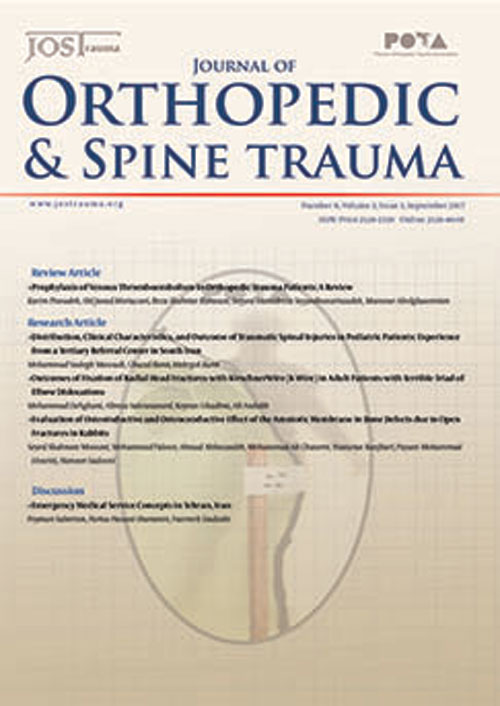فهرست مطالب

Journal of Orthopedic and Spine Trauma
Volume:3 Issue: 3, Sep 2017
- تاریخ انتشار: 1396/06/30
- تعداد عناوین: 5
-
-
Page 1
Orthopedic trauma is an area of significant controversy regarding indications and type of thromboprophylaxis. In 2014, the Iranian Orthopedic Association (IOA) organized a committee to review the available data to extract a national guideline to assist the orthopedic surgeons in decision making regarding the need and type of thromboprophylaxis for patients with orthopedic trauma. We found almost 12500 articles in regards to DVT and thromboembolism from PubMed and orthopedic journals from January 2004 to January 2017. We included only the articles related to orthopedic trauma patients (684 articles); then, we selected case control cohort and prospective studies (73 articles). Herein, we present a summary of the review.
Keywords: Trauma, Deep Vein Thrombosis, Guideline, Anticoagulation -
Page 2BackgroundSpine injuries are generally uncommon among children and adolescents; however, the impact on the affected patients can be devastating. The aim of this study was to investigate pediatric spinal injuries presenting to a tertiary trauma center in terms of epidemiology, mechanism, levels of the spinal involvement, and type of fracture, along with the associated morbidity and mortality.MethodsIn this prospective cross-sectional study, we reviewed 58 pediatric cases with traumatic spinal injuries admitted to the first-level emergency department of Namazi hospital, the largest tertiary care referral center in south Iran, over a 3 year time period from April 2015 to April 2018. Demographic information, clinical records, as well as necessary surgical managements undertaken for the patients were collected. We assessed the outcomes and mortality rate in short-term and long-term follow-ups after 3 years. Data are presented descriptively.ResultsOver the course of 3 years, a total of 58 consecutive pediatric patients with spinal trauma were admitted to the first-level emergency department of our center. The mean age of patients was 6.4 (2 - 17 years old). The male-to-female ratio was almost equal (1:1.2). The majority of patients were pedestrian victims. The multi-level thoracic spine, especially upper and middle thoracic area, was the most frequently injured region (44.4%). A total of 28.6% patients developed post-traumatic neurological deficits.ConclusionsWe concluded that despite the age or mechanism of injury, the most affected areas in the spinal column are upper and middle thoracic spine and in most of our cases there is multi-level fractures in thoracic spine.Keywords: Epidemiology, Spine, Spinal Injuries, Spinal Fractures, Pediatric Emergency Medicine, Child, Adolescent
-
Page 3BackgroundElbow dislocation is one of the most prevalent dislocations among adults, following shoulder dislocation. The present study aimed to evaluate the effects of Kirschner wire (K-wire) on fixation of comminuted radial head fracture when radial head prosthesis is inaccessible in terrible triad of elbow (TTE) dislocation.MethodsIn this retrospective study, a total of 21 adult patients with TTE dislocation, who were scheduled for fixation of radial head using K-wire, were enrolled according to the inclusion criteria. Variables, such as supination, pronation, range of flexion-extension motion, forearm rotation, and Mayo elbow performance score (MEPS) index, were measured, and the patients were followed-up for 1 postoperative year.ResultsAfter surgery, the mean forearm rotation and elbow joint flexion-extension range of motion were 121.42 ± 29.71 and 115.23 ± 32.34 in patients with TTE dislocation, respectively. Regarding the MEPS results, the mean MEPS score was above 70, and the majority of patients showed good performance in the follow-up.ConclusionsConsidering the limitations and side effects of prosthesis in TTE dislocation, K-wire can be used as an effective approach for fixing comminuted radial head fractures, such as TTE dislocation.Keywords: Kirschner Wire, Elbow Dislocation, Radial Head Fracture, Terrible Triad
-
Page 4BackgroundThe repair of long bone segmental defects is one of the most challenging problems in orthopaedic surgery.ObjectivesThe current researchers carried out animal experiments on the use of Human Amniotic Membrane (HAM) in bone defect to evaluate the osteoinductive and osteoconductive effects, and also to use it as a guide for regular production of bone without waiting for membrane production (MASQUELET method).MethodsTwenty New Zealand white male adult rabbits were used in the study, and divided to four groups. The surgical site was prepared with the purpose of working on the left forearm diaphysis. In each radius, a bone defect of 15-mm in length was created. The fixation of the radius was not done because the support of the ulna was sufficient. The defect was not filled with anything in group 1; however, a tube-shaped HAM was inserted in group 2, a Tendon-shaped HAM was utilized for group 3 and a Tube-shaped HAM bone graft (demineralized bone matrix, DBM) was used in group 4.ResultsBone formation was radiographically observed in the defects, which had been implanted using tube-shaped HAM (group 2), which was complete in 60% and partially complete in 40% of the cases. No bone formation was seen at up to eight weeks after surgery in group 1 and 3. A small amount of bone formation was observed at both ends and the ulnar site of the defect in group 4.ConclusionsThe results of the study indicated that tube-shaped HAM could have an osteoconductive effect in large segmental bone defects, yet could not have an osteoinductive effect.Keywords: Human Amniotic membrane (HAM), Rabbits, Osteoconductive, Osteoinductive

